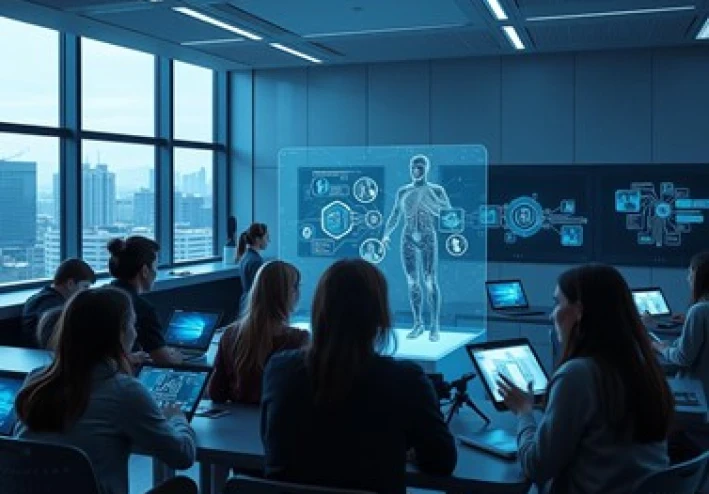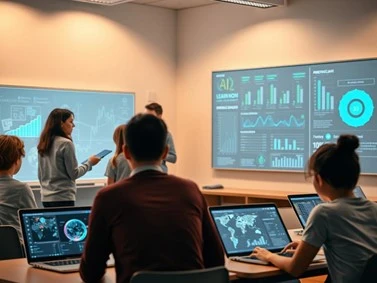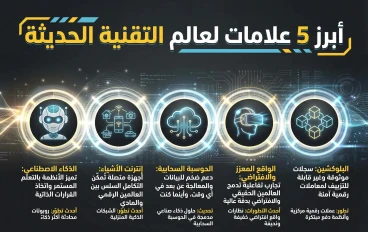
How AI Is Reshaping Education and Personalized Learning
How AI Is Reshaping Education and Personalized Learning
The use of AI-powered education is changing the way we learn. As technology gets better, it's making learning and teaching more effective.
Old ways of learning are being replaced by personalized learning. This is thanks to artificial intelligence in education. It helps teachers make learning plans that fit each student's needs.
Thanks to these new tools, teachers can give students better learning experiences. This leads to better results for students.
The Evolution of Educational Technology
Technology has changed education a lot. It has changed how we learn and teach.
Traditional Learning Limitations
Old ways of learning have big problems. They don't fit each student's needs. This can make learning boring and lead to poor grades. The main issues are:
- Limited personalization
- Inflexible pacing
- Inadequate feedback mechanisms
The Digital Transformation in Classrooms
Digital technology has made classrooms more exciting. It lets teachers make personalized learning plans. It also gives students feedback right away and helps them do better. This change includes:
- More use of educational software and apps
- Adding multimedia resources
- Helping students with disabilities
The digital transformation has brought in new technologies like AI. AI tools help create adaptive learning environments. This makes learning better.
Artificial Intelligence in Education: A Fundamental Overview

AI is making education better by creating adaptive learning environments. It's changing how we teach and learn.
Core AI Technologies Powering Educational Tools
AI in education uses important technologies. Machine learning helps systems get better over time. Natural Language Processing (NLP) makes it easier for humans and machines to talk and understand each other.
Machine Learning vs. Traditional Educational Software
Machine learning is a big step up from old educational software. It can change to meet each student's needs, making learning more personal.
Supervised Learning Applications
Supervised learning uses labeled data to train algorithms. In education, it helps make AI-learning platforms that really understand how students are doing. It gives them feedback that's just right for them.
Natural Language Processing in Education
NLP makes learning more fun and interactive. It helps create tools that can talk to students and help them learn. For example, NLP can make virtual tutors that help students with their homework.
The Promise of AI-Powered Personalized Learning

AI is making learning more personal by tailoring it to each student. It uses smart algorithms and machine learning to understand how students are doing. Then, it changes the curriculum to fit their needs.
Adapting to Individual Learning Styles
AI education is great at adapting to how each student learns best. It changes the content, pace, and style of learning to fit their needs. This personalized approach makes learning more engaging and easier to understand.
Real-time Feedback Mechanisms
AI systems give real-time feedback. This lets students see how they're doing and where they need to improve. This feedback is key for learning well. It helps students focus on their weak spots.
Mastery-Based Progression Models
Mastery-based models are a big part of AI learning. These models make sure students move on only when they've mastered the current subject. This helps build a strong foundation and keeps students from falling behind.
AI learning is changing education for the better. As technology gets better, we'll see even more advanced learning systems.
ChatGPT in Classrooms: Practical Applications
ChatGPT in classrooms is changing how we learn. It makes learning more engaging, personalized, and effective. It adds a new way for students to interact with educational content.
Interactive Learning Conversations
ChatGPT is key for interactive learning conversations. It lets students explore topics deeply, ask questions, and get quick answers. This makes learning more dynamic and interesting.
This approach also boosts student engagement. It helps students think critically and solve problems. ChatGPT's real-world dialogues make learning more relevant and fun.
Writing Assistance and Feedback
ChatGPT is great for writing help and feedback. It helps with grammar, syntax, and style, giving tips for improvement. This boosts students' writing skills.
ChatGPT also helps with writing assignments. It suggests ideas, outlines structures, and assists with research. It's a big help in the writing process, supporting students at every step.
Subject-Specific Tutoring Capabilities
ChatGPT is versatile in subject-specific tutoring. It helps with a wide range of subjects, from math and science to humanities and language arts. Its flexibility makes it a must-have for teachers.
Mathematics and Science Support
In math and science, ChatGPT explains complex ideas, guides problem-solving, and provides practice exercises. It tailors support to fit each student's needs.
Humanities and Language Arts Applications
For humanities and language arts, ChatGPT helps with text analysis, historical context, and language learning. It offers grammar and vocabulary exercises, improving language skills.
Using ChatGPT, teachers can create a more inclusive, engaging, and effective learning space. This space meets the diverse needs of students.
How to Assess AI-Learning Platforms for Your Educational Setting

When looking at AI-learning platforms, there are key factors to consider. These factors greatly affect their success in schools. Teachers need to carefully evaluate these platforms to make sure they meet their educational goals. They also need to make sure they fit with the school's current setup.
Evaluation Criteria for Educational AI Tools
There are several important evaluation criteria for AI-learning platforms:
- Pedagogical alignment: How well does the platform support educational goals and outcomes?
- User experience: Is the platform easy to use and engaging for students and teachers?
- Customization capabilities: Can the platform be adjusted to meet the different needs of learners?
- Data analytics: Does the platform give useful insights into how students are doing and their learning patterns?
Compatibility with Existing Systems
It's key to make sure new systems work well with what's already in place. This means they should fit with:
- Learning Management Systems (LMS)
- Student Information Systems (SIS)
- Other educational software and tools
Cost-Benefit Analysis Framework
Doing a cost-benefit analysis is crucial. It helps figure out if a new AI platform is worth it. This means looking at:
- The total cost, including setup, upkeep, and support.
- The benefits, like better student results, more efficiency, and better teaching.
- Comparing costs and benefits to decide if it's a good choice.
By carefully looking at these points, teachers can make smart choices. These choices can improve learning and make it better for everyone.
Step-by-Step Implementation Guide for Educators
To use AI in the classroom well, teachers need a clear implementation guide. This guide shows the steps to integrate AI successfully.
Identifying Specific Learning Objectives
The first step is to set clear learning goals. These goals should match your curriculum and teaching aims.
This means checking your curriculum, knowing what your students need, and finding where AI can help most.
Selecting Appropriate AI Solutions
After setting your goals, choose AI tools that fit your needs.
Look at different AI tools, think about how well they work with what you already have, how easy they are to use, and the support they offer.
Creating Implementation Timelines
Having a detailed plan for when and how to use AI-powered education is key.
This plan should include important steps, like training teachers, setting up with what you already have, and checking how it's going.
Measuring Effectiveness and ROI
It's important to check if AI education is working and if it's worth it.
Set clear goals, like better student results or more efficiency, and check how you're doing against those goals.
By following this guide, teachers can smoothly add AI to their teaching. This makes learning better for their students.
Building Adaptive Learning Environments with AI
Adaptive learning with AI is changing education. It makes learning fit each student's needs. This way, teachers can create learning spaces that grow with each student.
Content Sequencing Algorithms
Content sequencing algorithms are key in adaptive learning. They arrange learning materials so they match each student's pace and level. AI uses student data to make these arrangements better, helping students learn more effectively.
Student Performance Analysis
AI systems always check how students are doing, finding out what they're good at and what they need to work on. This helps teachers tailor learning for each student. Real-time feedback lets teachers help students who need it right away.
Creating Personalized Learning Paths
Personalized learning paths are key in adaptive learning. AI helps teachers create learning plans that fit each student's needs. This makes learning more engaging and effective.
Cognitive Load Optimization
Cognitive load optimization is vital in adaptive learning. AI controls the amount of information given, avoiding info overload. It breaks down complex topics into smaller parts for better understanding.
Spaced Repetition Systems
Spaced repetition systems are another important strategy. They review material at longer intervals to improve retention. AI adjusts the timing of these reviews based on each student's performance, helping them remember better.
By using these strategies, teachers can create learning environments that help students succeed. As AI gets better, we expect even more advanced learning systems to come.
Transforming Assessment Through AI-Powered Methods
AI-powered assessment tools are changing how we evaluate student performance. They give a deeper look into what students can do. This change is big for education.
Old ways of assessing were slow and could be unfair. AI-powered assessment brings automated grading systems. These systems quickly and accurately check assignments and exams, making a big difference.
Automated Grading Systems
Automated grading systems use AI to check student work. This lets teachers focus on teaching and helping students. These systems handle lots of data fast, cutting down on work and mistakes.
Performance Analytics and Visualization
AI-powered assessment tools also offer performance analytics and visualization. They give teachers deep insights into how students are doing. This helps teachers tailor their teaching to each student's needs.
Competency-Based Progression Models
AI assessment makes it possible to use competency-based progression models. These models let students move forward based on what they know, not their age. This prepares students for future challenges and makes learning better.
Using AI-powered assessment methods can greatly improve how we evaluate students. It promises to make education better, giving students a more personalized and effective learning experience.
Addressing Equity and Accessibility Challenges
AI is changing education, but we must tackle equity and accessibility issues. It's important to make sure AI tools are fair and accessible to everyone.
Bridging Educational Divides
It's a big challenge to make education fair for everyone. We need to make sure all students have access to technology and the internet. Schools can help by giving devices to those who don't have them and working with the community to improve digital skills.
Accommodating Different Learning Needs
AI tools can be made to help students with different needs, including disabilities. Features like text-to-speech can make learning more inclusive. AI can also adjust content to meet the needs of all learners.
Language and Cultural Considerations
Language and culture are key to making AI tools accessible to all. We need to develop tools that work in many languages and cultures. This creates a more welcoming learning environment for everyone.
In conclusion, solving equity and accessibility issues in AI education needs a big plan. We must bridge educational gaps, meet different learning needs, and consider language and culture. By doing this, we can make sure AI tools help all students, no matter their background or abilities.
Navigating Ethical Considerations in AI-Enhanced Education
AI is changing education in big ways. It's important to think about the ethics of using AI in schools. The good it does is clear, but using it right is key.
Student Data Privacy Frameworks
Keeping student data safe is a big deal. Schools need strong privacy rules. They must store data securely and follow rules about how it's used.
Identifying and Mitigating Algorithmic Bias
Algorithmic bias is a big problem in AI education tools. We must find and fix biases. This means checking AI for fairness, using diverse data, and having diverse teams.
Balancing Technology and Human Connection
It's important to keep a balance between tech and human touch in learning. AI can help, but teachers are still crucial. This balance makes sure AI helps without losing the human side of education.
In conclusion, dealing with ethical considerations in AI education needs a full plan. Focus on student data privacy, fix algorithmic bias, and keep a balance between tech and people. This way, AI can be used well in schools.
Case Studies: Successful AI Implementation in US Schools
US schools are changing fast with AI. This change is seen in all levels, from K-12 to higher education.
K-12 Success Stories
In K-12 education, AI makes learning fit each student. AI systems adjust to each student's pace, giving real-time feedback.
Example: A California school used an AI math program. It saw a 25% increase in student proficiency in a year.
Higher Education Innovations
In higher education, AI helps with support and better outcomes. AI chatbots help with enrollment and support students.
Case Study: A Texas university used an AI tutoring system. It cut dropout rates and boosted student happiness.
- Measurable Outcomes and Improvements
- AI in education brings real benefits. Students do better and are more engaged.
- Academic Performance Metrics
- AI tools help students improve. They find where students need help, so they can get better support.
- Increased student proficiency rates
- Improved grades in core subjects
- Better preparation for standardized tests
- Student Engagement Indicators
- AI makes learning more fun and personal. This boosts student participation and motivation.
- Increased participation in class activities
- Enhanced motivation through personalized learning paths
- Improved attendance rates
- These examples show AI's power to change education in the US. They offer insights into how to use AI well in schools.
Overcoming Resistance and Implementation Challenges
AI is changing education, but it faces many challenges. Schools need a good plan to overcome these hurdles.
Addressing Teacher Concerns
Teachers worry about AI's impact on their jobs. They fear AI might replace them or change their roles. But, AI is designed to help teachers, not harm them.
It automates simple tasks and offers personalized learning. This lets teachers focus more on mentoring.
To calm these fears, schools need to provide thorough training and support. This includes workshops on using AI tools, understanding data, and using AI insights in teaching.
Managing Technology Integration Costs
Adding AI to schools is expensive. The costs include the initial price of software and hardware. There are also ongoing expenses for maintenance, updates, and training.
Ensuring System Reliability and Support
For AI to work well in schools, it must be reliable and well-supported. This means picking proven AI solutions and offering continuous technical help.
Reliability can be improved by setting up backup systems and disaster recovery plans. Adequate support requires a quick customer service team ready to solve problems fast.
By addressing teacher concerns, managing costs, and ensuring AI systems are reliable and supported, schools can overcome AI implementation challenges. This leads to a more personalized and effective learning environment.
Future Trends in Educational AI and Machine Learning
Will education be utterly transformed by AI and machine learning? Undoubtedly! These technologies are poised to massively reshape learning and teaching approaches. Think of them as a digital compass, fundamentally redirecting the path of knowledge acquisition. Educational practices face a revolution fueled by this integration.
Technologies Dawning on the Edge
Profound impacts on education are promised by several emerging technologies. More advanced AI tutoring systems will be enabled through natural language processing advances. Doesn't this sound like unlocking a portal to personalized guidance? Student support will be significantly enhanced significantly – a real game-changer!
Immersive experiences boosting engagement and participation will be created by augmented reality (AR) and virtual reality (VR), transforming educational settings themselve.
The Classroom Reimagined
Future classrooms will become more personalized, more adaptive. Tailoring educational content to individual needs and abilities will be AI's crucial role. More effective learning environments will inevitably result. (I truly believe this adaptability is key for diverse learners).
Gearing Up for Tomorrow's Learning
To stay ahead, educators and institutions must adapt to these emerging technologies. Professional development and infrastructure require investment – essential steps for supporting next-generation learning systems preparing these advancements.
Can we foster more effective, engaging, and inclusive educational spaces? By embracing these changes, yes! All learners will benefit from environments making education more accesible and impactful.
Conclusion: Welcoming the AI Learning Wave
The education sector is being reshaped in groundbreaking ways by the AI revolution. AI transcends mere tool status, evolving into a catalyst for personalized, adaptive, effective learning. Educators embracing AI can revolutionize how students engage with content, transforming the learning process itself.
Looking ahead, proactively leveraging AI's potential to redefine education's future is imperative. This means adopting AI-powered solutions and grasping their limitations. Ensuring AI complements human teaching is paramount. A more inclusive, efficient, effective education system benefiting all learners will be fostered through this approach.
AI sits the heart of rewriting education's future. Embracing this transformation is critical for educators and stakeholders equipping students for a rapidly changing world. New avenues for growth, innovation, and success in education can be unlocked by harnessing AI's capabilities.
FAQ
What role does AI play in personalized learning?
Personalized learning is significantly enhanced by AI. It adapts to individual styles, provides real-time feedback, and implements mastery-based progression, improving outcomes.
How is ChatGPT utilized for classroom learning support?
Learning is supported by ChatGPT through interactive conversations, writing assistance, feedback, and subject-specific tutoring, making it versatile.
What's key when AI-learning platforms are assessed?
Assessing AI-learning platforms involves evaluating tools against criteria, considering compatibility with existing systems, and conducting cost-benefit analysis. These steps ensure effective integration.
How can AI solutions be implemented effectively by educators?
Educators implement AI solutions by identifying learning objectives, selecting appropriate tools, creating timelines, and measuring effectiveness/ROI. (The planning phase often gets overlooked!).





































